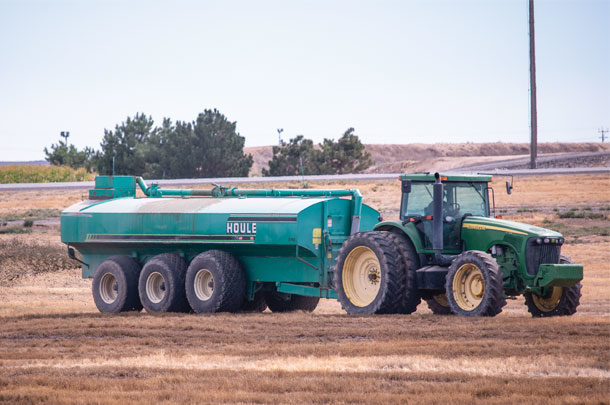Having a handle on your crop rotations, fertilizer and seed purchases and manure management plans ahead of next spring helps determine manure allocation and need for fertilizer nitrogen (N), phosphorus (P) and potassium (K).
Cropping decisions are critical since they impact livestock performance, environmental risk, farm nutrient efficiency and profitability. Projecting forage inventory is the first step in assessing soil fertility needs and should be based on the farm’s latest animal numbers and cropping acres.
Optimizing nutrient allocation starts from the ground up – with a proper soil sample. Sampling after harvest and prior to manure or fertilizer application in the fall is arguably the best time. Nutrient uptake by annuals is complete and soil biological activity has slowed.
Guidelines for sampling
Routine sampling uses one composite sample per field. Taking an adequate number of cores per field (10 to 15) and avoiding atypical areas (wet spots, headlands) when sampling is important. Some universities suggest an upper limit on the field area represented by one sample (typically less than 20 acres). Fields should generally be sampled every two to four years (concentrated animal feeding operation [CAFO] farms are mandated to sample once every three years).
Whereas traditional soil sampling (i.e., one sample for one field) ignores spatial variation, precision-based programs take advantage of it via systematic sampling (1- to 2-acre grids are common) to create “management zones” with similar requirements to increase nutrient use efficiency.
With reduced tillage, soil organic matter (SOM), P and other nutrients concentrate at the surface from lack of tillage. Taking a surface and a deeper soil sample to assess nutrient stratification and adjust fertilizer recommendations accordingly may be appropriate for long-term no-till fields.
At a minimum, soil pH, SOM and plant-available P and K should be included in a soil test. State land grant universities develop fertility guidelines for each state, so soil testing and crop nutrient recommendations for different regions and crops are readily available.
Key soil elements
Soil pH is critical. Besides soil biology (microbial activity, N fixation by rhizobia and other processes), pH affects aluminum solubility and toxicity, P availability and ag lime requirements. Soil P is most readily available at a pH close to neutral (7.0) in part because aluminum and iron are largely insoluble at this pH. A low-pH field with low P should receive adequate lime before more P is applied. It is best to apply lime at least six months ahead of seeding to allow adequate time for neutralization to occur.
The importance of SOM cannot be overemphasized for crop production and sustainability. The current interest in soil health is largely based on managing SOM dynamics. Besides its nutrient and water-holding capacity, SOM underpins aggregate formation and stability, promoting better aeration and water infiltration.
Integrating manure
Since fertilizer is a large farm expense, accurate accounting of crop nutrient needs has important economic implications. While land grant university nutrient recommendations vary, the importance of using manure to help meet crop N, P and K needs is a common focus.
Dairy manure is an excellent source of N, P, K and micronutrients, but regular testing is needed to accurately determine nutrient content of manure types (liquid, semi-solid, bedded pack, etc.). While N behavior is more complicated, P and K can be substituted on a 1:1 basis for fertilizer P and K. In fact, P from dairy manure is more available in some soils than equivalent amounts of fertilizer P.
Making the most of manure on forages means having a good plan. Where are the opportunities to integrate manure? Where are N, P and K needed most? Are manure rates N or P based? How early can manure be applied in the spring and on what fields? Are you comfortable applying manure to alfalfa-grass? What about grass-alfalfa? How far will you transport manure? What field characteristics limit manure application? Are there pathogen transmission concerns? Will dry hay or silage be produced?
Answering the where, when and how of manure application drives the overall fertility program and need for additional fertilizer.
Despite abundant N in dairy manure, corn and grass hay are often still N-limited due to their propensity for loss. Meeting some or all of required N, P and K with manure is a good strategy for most dairy forage crops. However, it is important to consider maximum application rates in the absence of other factors limiting N or P application. Alfalfa is particularly sensitive to heavy equipment, compaction and sensitive to manure application after regrowth. Even with straight grass, the same issues can arise and reduce the benefit of manure application.
Application methods
Manure application methods strongly affect N and P loss potential and are often related to tillage systems. Conventional systems can use tillage implements to incorporate manure (chisel plow, disk, disk-harrow), whereas strict no-till systems either surface apply or inject with low-disturbance equipment (shallow disk injection, aerator and/or band). Since ammonia-N rapidly volatilizes and P is much more vulnerable to surface runoff loss when manure is not incorporated or injected, incorporating and/or injecting makes both economic and environmental sense.
Recent ARS research showed that shallow disk injection of liquid dairy manure into alfalfa-grass substantially reduced dissolved N and P in simulated runoff (compared to surface broadcast) and did not appear to negatively impact crop integrity. Banding and aeration manure also reduced nutrient loss but was not as effective as shallow disk injection. More work is being done in this area to better understand agronomic effects of low-disturbance manure application on forages.
It’s important to realize that issues beyond crop nutrient requirements need full consideration anytime manure is applied, including neighbor relations, pathogen transmission (to livestock and humans) and environmental concerns. These may often override pure agronomic needs.
The bottom line is that manure can meet much of a typical dairy farm’s forage crop N, P and K needs with proper planning. Applying manure to maximize nutrient utilization while minimizing crop damage, odor and environmental losses will continue to be an active research area. Fall is a busy time of year on farms. Besides harvesting crops, never-ending field operations and routine chores, timely decisions are needed. ![]()
PHOTO: Proper planning and efficient application of manure can fulfill a typical dairy farm’s forage crop N, P and K needs. Photo by Lynn Jaynes.

-
Eric Young
- Research Soil Scientist
- Institute for Environmentally Integrated Dairy Management
- USDA – Agricultural Research Service
- Email Eric Young














